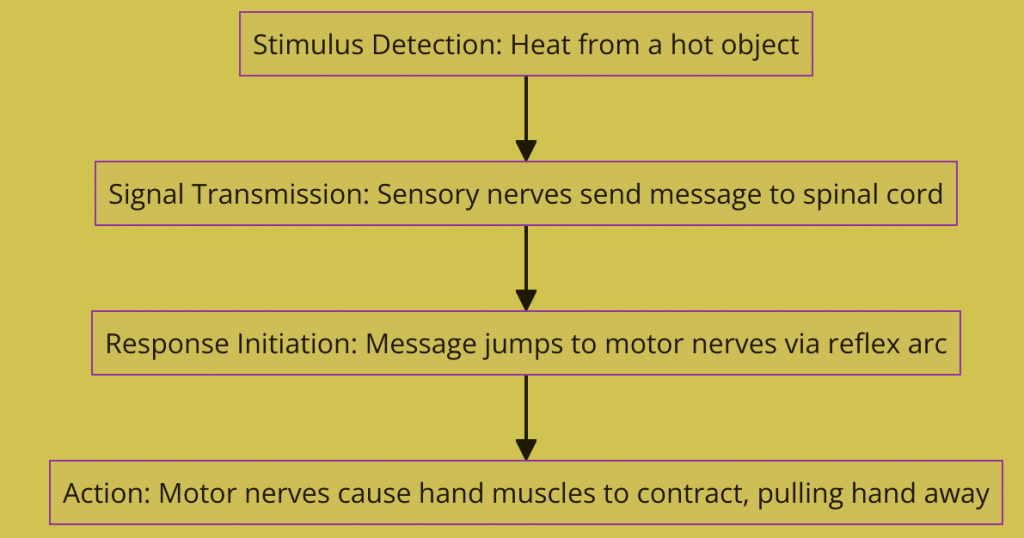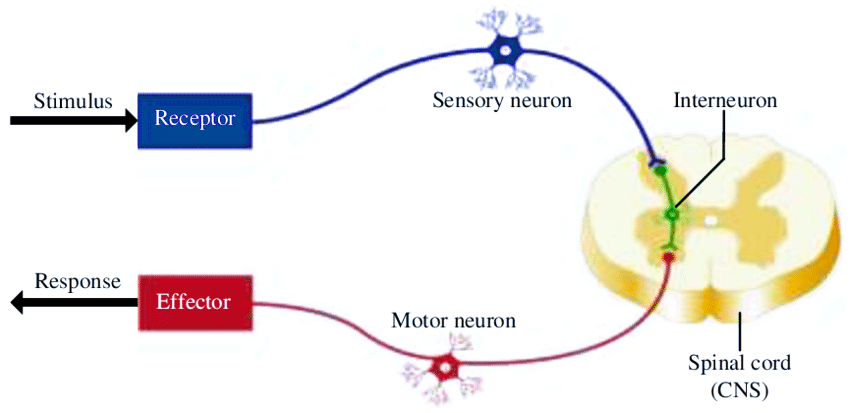Table of Contents
What is a Reflex Action?
A reflex action is like your body’s instant reaction to something happening around you, without you needing to think about it. Imagine you touch something really hot, and you pull your hand back super quickly. That’s your body doing a reflex action. It’s your body’s way of protecting you, making sure you react fast enough to avoid getting hurt.
Why Reflex Actions Occur
- Immediate Response- Reflex actions allow for an immediate response to potentially dangerous situations, bypassing the slower process of conscious thought. This is crucial for survival, as it enables quick reactions to avoid harm.
- Complexity of Thinking: Conscious thought involves complex interactions among neurons, which can be time-consuming. In situations requiring quick action, such as avoiding a hot object, this delay could result in injury.
How Does a Reflex Action Work?
Reflex actions follow a specific path in your body called a reflex arc. Let’s break it down step by step-

- Stimulus Detection- First, something catches your attention, like the heat from a hot object. The sensory nerves in your skin are like your body’s scouts; they notice this heat.
- Signal Transmission- These sensory nerves act quickly. They send a message up to your spinal cord, which is like a big highway for nerve signals. But they don’t send the message to your brain because that would take too long. It’s like taking a shortcut to get somewhere faster.
- Response Initiation- Inside your spinal cord, the message from the sensory nerves jumps directly to some motor nerves. This jump happens through the reflex arc, which is like a quick bridge from sensing something to doing something about it.
- Action- The motor nerves then tell the muscles in your hand to contract, which pulls your hand away from the hot object. This all happens without you having to think, “Oh, this is hot, I should move my hand.” It’s automatic!
Location and Formation of Reflex Arcs

- Spinal Cord: Reflex arcs are primarily located in the spinal cord, which acts as a relay station. Sensory neurons connect directly to motor neurons within the spinal cord, allowing for quick responses without involving the brain.
- Evolutionary Aspect: Reflex arcs are believed to have evolved as a means to ensure quick responses in the absence of complex thought processes, which are not present in many animals. Even in organisms with complex nervous systems, reflex arcs provide an efficient means of response.
Also Check – What is Reflex Arc for Class 10
The Role of the Brain
- Conscious Awareness- Although the reflex action itself bypasses the brain, the information about the stimulus is eventually relayed to the brain. This allows the individual to become aware of the stimulus and the body’s response to it, enabling learning and adaptation.
Tricky Questions on Reflex Actions
Question- Why don’t reflex actions involve the brain, even though the brain is the centre of the nervous system?
- Answer- Reflex actions bypass the brain to provide a quicker response. The pathway through the reflex arc in the spinal cord is shorter and faster, which is crucial for immediate reactions to potentially harmful stimuli.
Question- Can you name a reflex action that involves a part of the body other than the hand moving away from something hot?
- Answer- Yes, the knee-jerk reflex is another example. When the knee is tapped just below the kneecap, it causes the leg to extend automatically.
Question- If reflex actions are automatic, why do we sometimes fail to pull our hand away from something hot immediately?
- Answer- Several factors could cause a delay, such as distractions, nerve damage, or a slow reaction time due to various reasons like age or health conditions.
Question- How does the body decide which actions should be reflexive and which should involve conscious thought?
- Answer- Reflex actions are typically those that protect us from harm, evolved over time for survival. Actions requiring complex decision-making or those not directly related to immediate survival involve conscious thought.
Question- Why do doctors test reflexes, like the knee-jerk reflex, during a physical examination?
- Answer- Testing reflexes helps doctors assess the health of the nervous system. Abnormal reflex responses can indicate issues within the nervous pathways or brain.
Question- If the sensory nerve detects a stimulus but the motor nerve does not respond, what could be the possible reason?
- Answer- The issue could be a disruption in the reflex arc, such as damage to the motor nerve, spinal cord injury, or a problem in the connection between sensory and motor nerves.
Question- How does the brain eventually get involved in a reflex action if it doesn’t play a role in the immediate response?
- Answer- After the reflex action, the sensory information continues to the brain, making you aware of the stimulus and the action taken, allowing for learning and adaptation.
Question- Why are reflex actions faster than actions that involve conscious decision-making?
- Answer- Reflex actions are faster because they involve a direct, shorter pathway through the reflex arc in the spinal cord, bypassing the complex processing required by the brain for conscious decisions.
Question- Can reflex actions be modified or suppressed consciously?
- Answer- To some extent, yes. With training and conscious effort, people can modify or suppress certain reflex actions, although this can be difficult and is not always possible for all reflexes.
Also Check – Reflex actions of knee joint afferents during contraction of the human quadriceps
Question- How do reflex arcs contribute to the evolutionary advantage of an organism?
- Answer- Reflex arcs provide a quick response to danger, reducing the chance of injury and increasing survival rates, which is beneficial in the evolutionary process.
Question- If reflex actions are not controlled by the brain, how do we feel pain from a stimulus that causes a reflex action?
- Answer- Even though the reflex action itself bypasses the brain, the sensory information about the stimulus (like pain from a hot object) is still sent to the brain. This allows you to feel the pain, which is the body’s way of signalling that something is harmful.
Question- Why do babies have certain reflex actions that disappear as they grow older?
- Answer– Many reflexes in babies, such as the grasp reflex, are thought to be evolutionary remnants that serve protective roles. As the baby’s nervous system matures and the brain develops more control over movements, these reflexes are no longer needed and thus disappear.
Question- Can reflex actions vary in intensity, and if so, what factors influence this?
- Answer- Yes, the intensity of reflex actions can vary based on the strength of the stimulus, the individual’s current state (like alertness or fatigue), and even the health of the nervous system.
Question- Is it possible for some people to have faster reflex actions than others, and what could cause these differences?
- Answer- Yes, reflex speeds can vary among individuals due to factors like age, muscle fitness, nerve health, and even practice or training in certain activities that can enhance the efficiency of the reflex arcs.
Question- How do reflex actions contribute to homeostasis in the human body?
- Answer- Reflex actions like shivering when cold or sweating when hot are part of the body’s automatic mechanisms to maintain a stable internal environment (homeostasis), adjusting bodily functions in response to external changes without conscious effort.
Question- In the context of reflex actions, what is meant by the term “withdrawal reflex,” and can you give an example?
- Answer– The withdrawal reflex is a specific type of reflex action that involves pulling back from a harmful stimulus to avoid injury. An example is the rapid withdrawal of your hand if you accidentally touch a sharp object.
Question- Why might reflex actions be used as an indicator of neurological health in medical examinations?
- Answer- Abnormalities in reflex actions, such as exaggerated reflexes or lack of reflex response, can indicate issues in the nervous system, including potential damage to nerves, the spinal cord, or the brain, making them valuable diagnostic indicators.
Question- How does alcohol or other nervous system depressants affect reflex actions?
- Answer- Alcohol and other depressants can slow down the nervous system, leading to slower reflex responses. This is because these substances interfere with the nerve signal transmissions involved in reflex arcs.
Question- Are there any reflex actions that involve the brain instead of the spinal cord, and what are they called?
- Answer- Yes, some reflexes involve brain centres, such as the blinking reflex in response to sudden bright light or an object approaching the eyes. These are called cranial reflexes, as they are mediated by cranial nerves connected directly to the brain.
Question- How do protective reflexes, like coughing or sneezing, fit into the concept of reflex actions?
- Answer- Protective reflexes like coughing or sneezing are automatic responses to clear the airways of irritants or pathogens, fitting the definition of reflex actions as they are rapid and involuntary, aimed at maintaining health and preventing harm.
Also Check – Difference between Voluntary and Involuntary Action- In Details and Tabular Format
